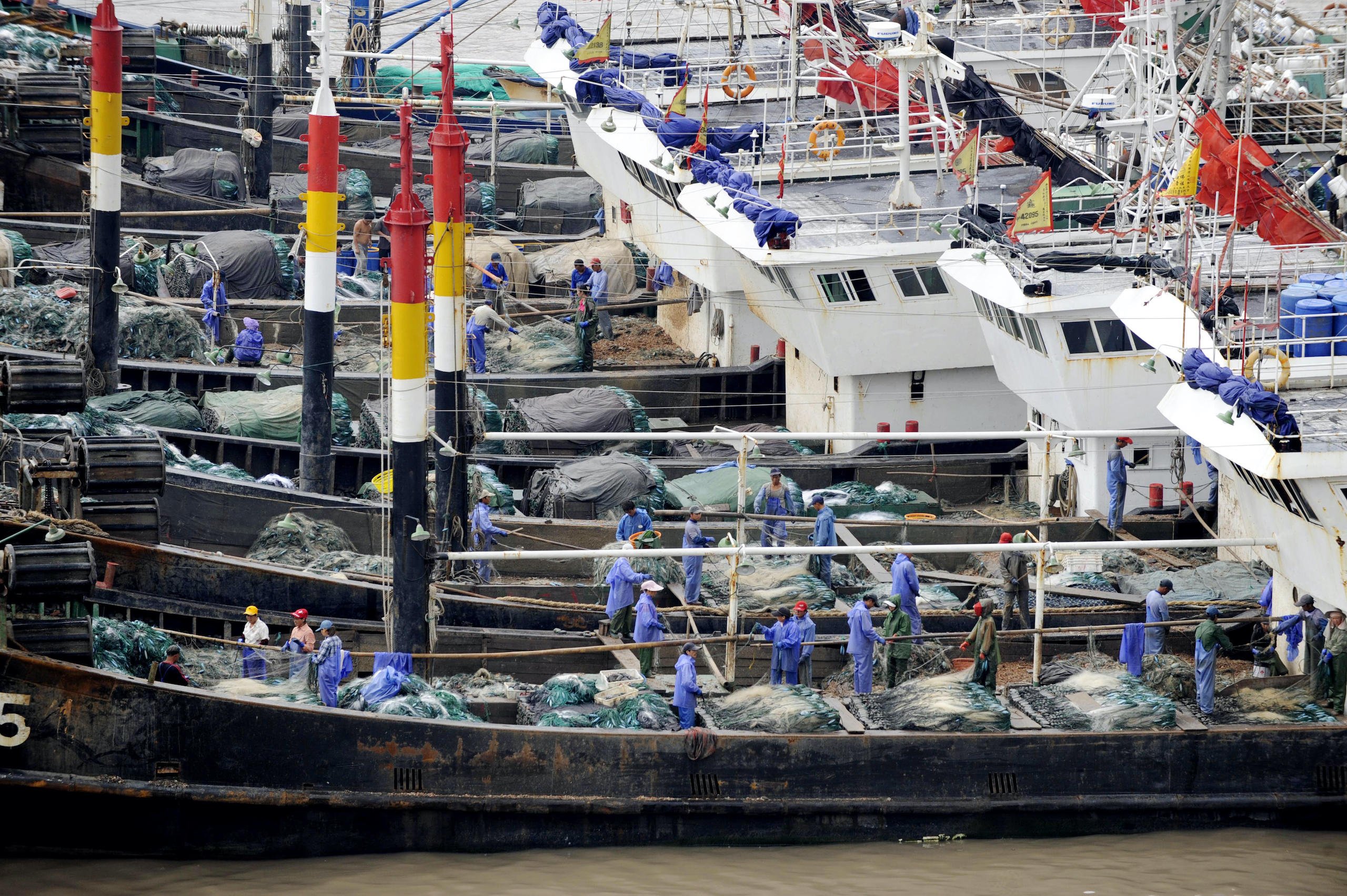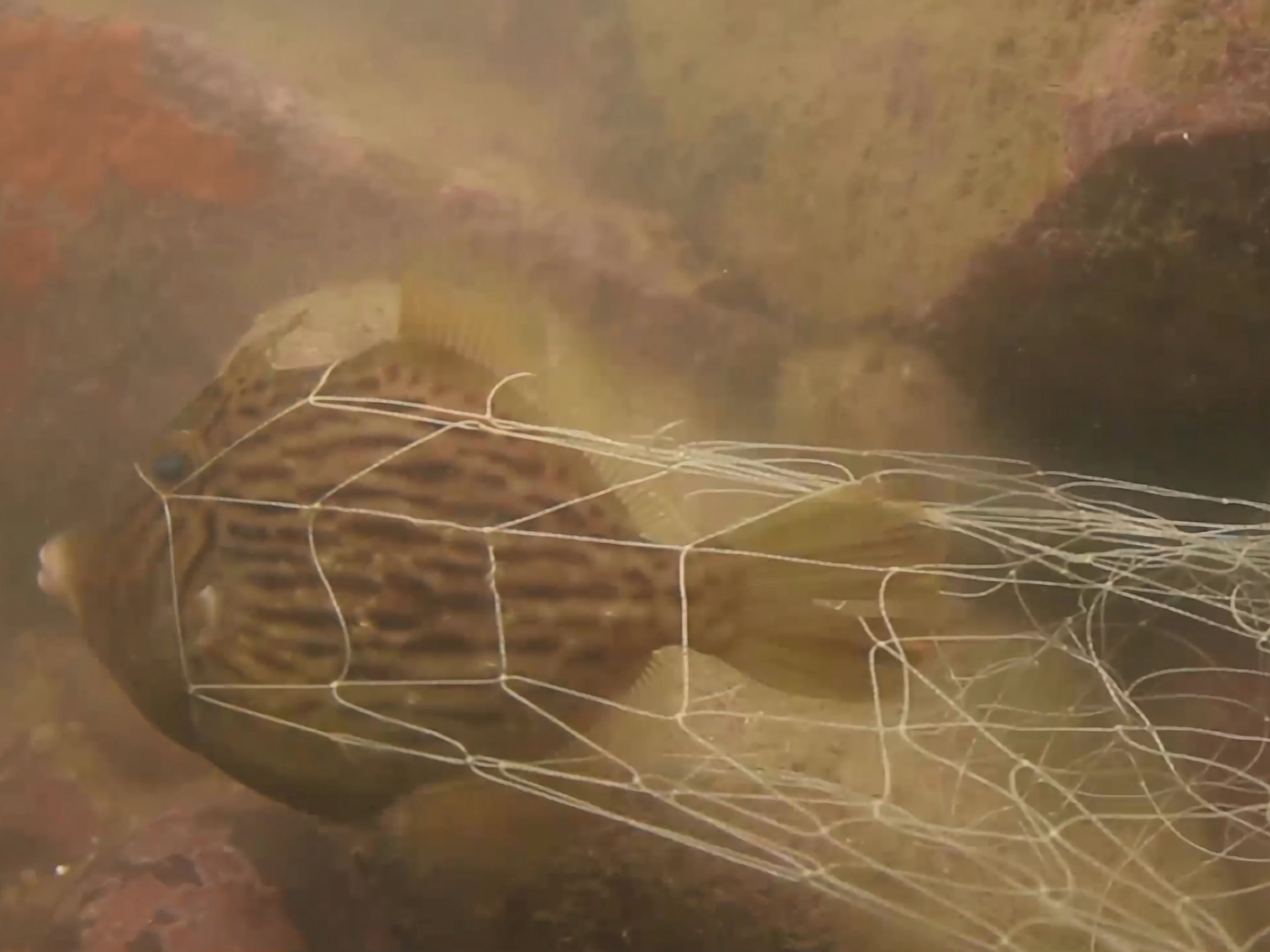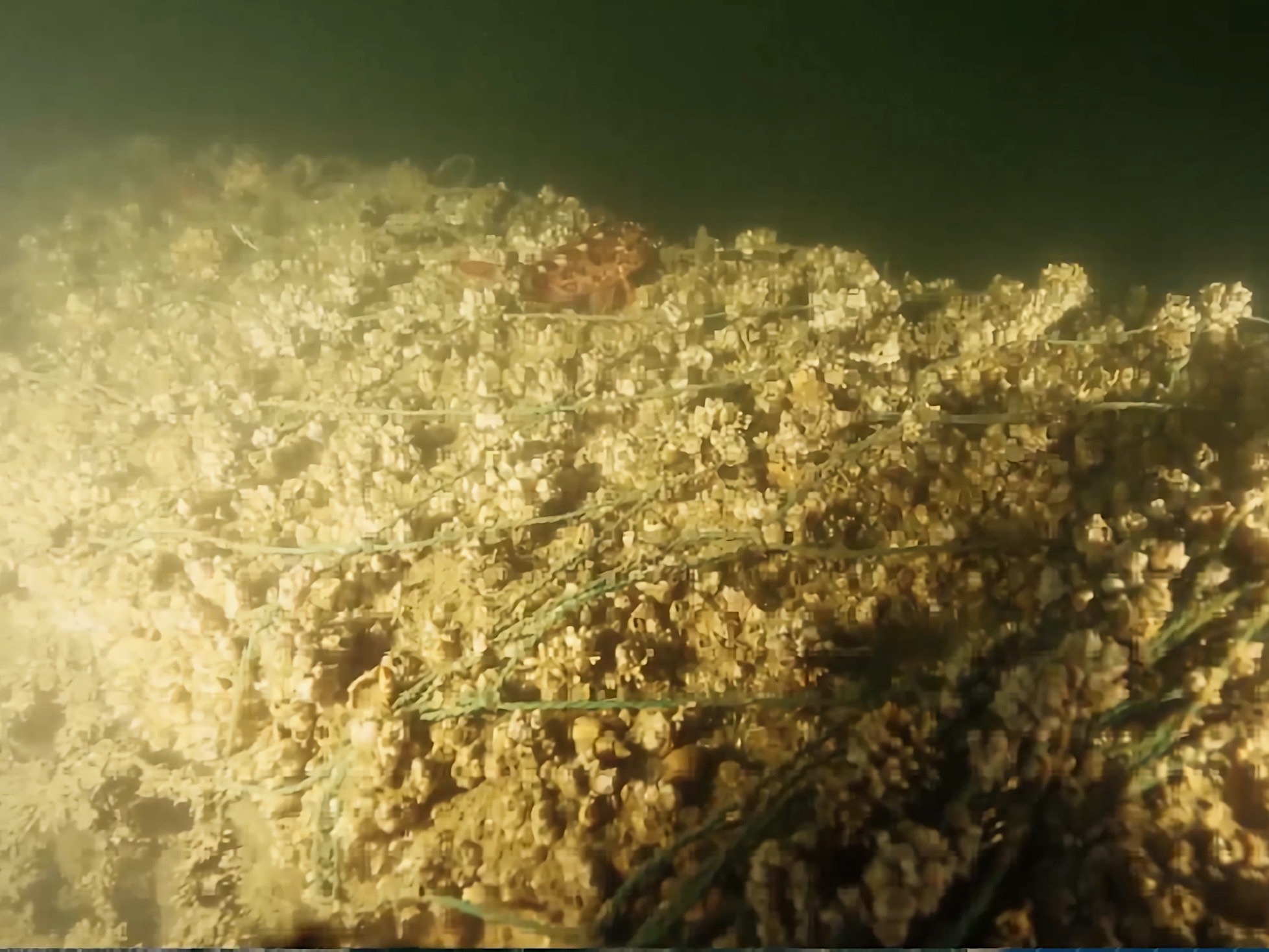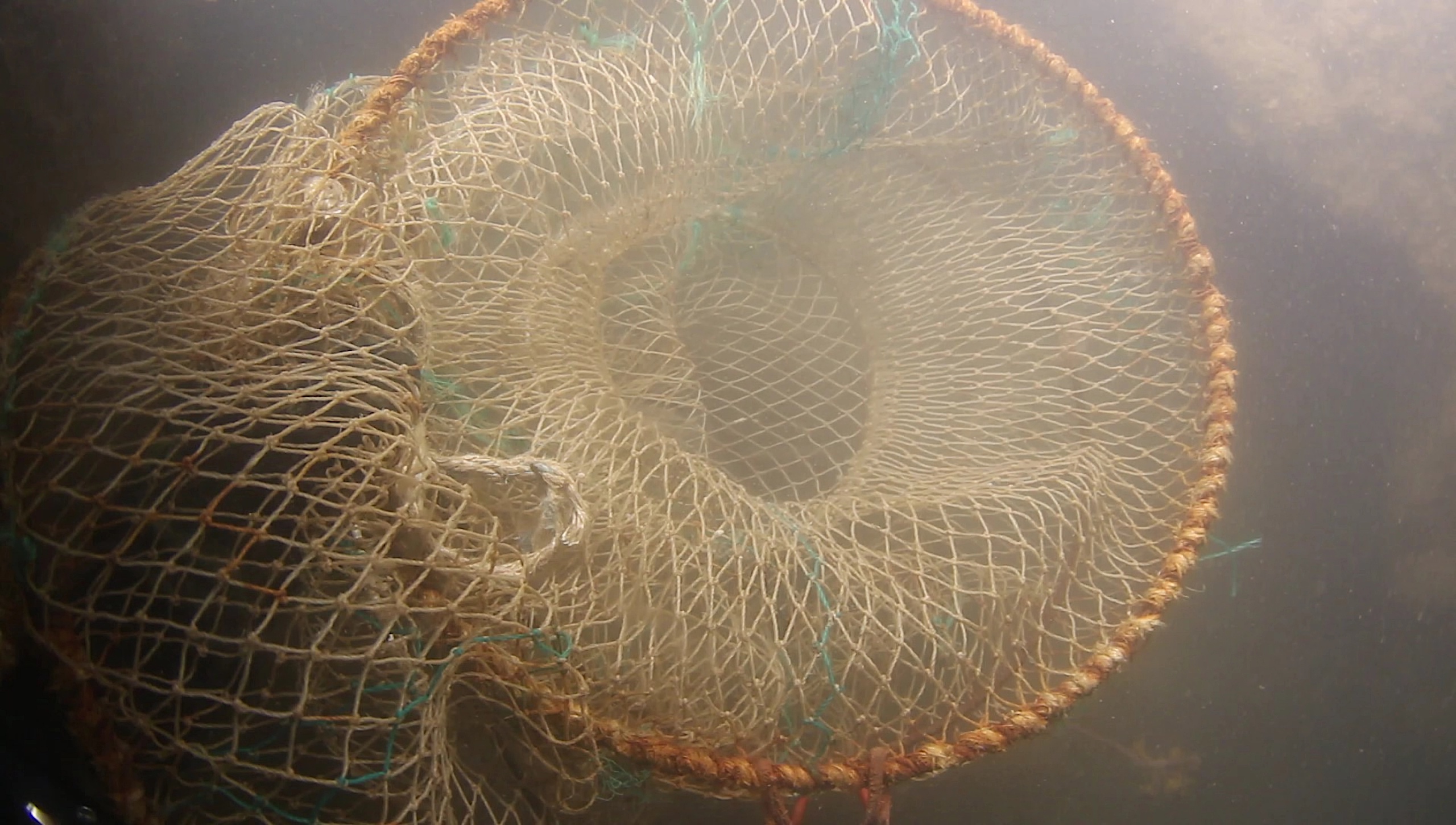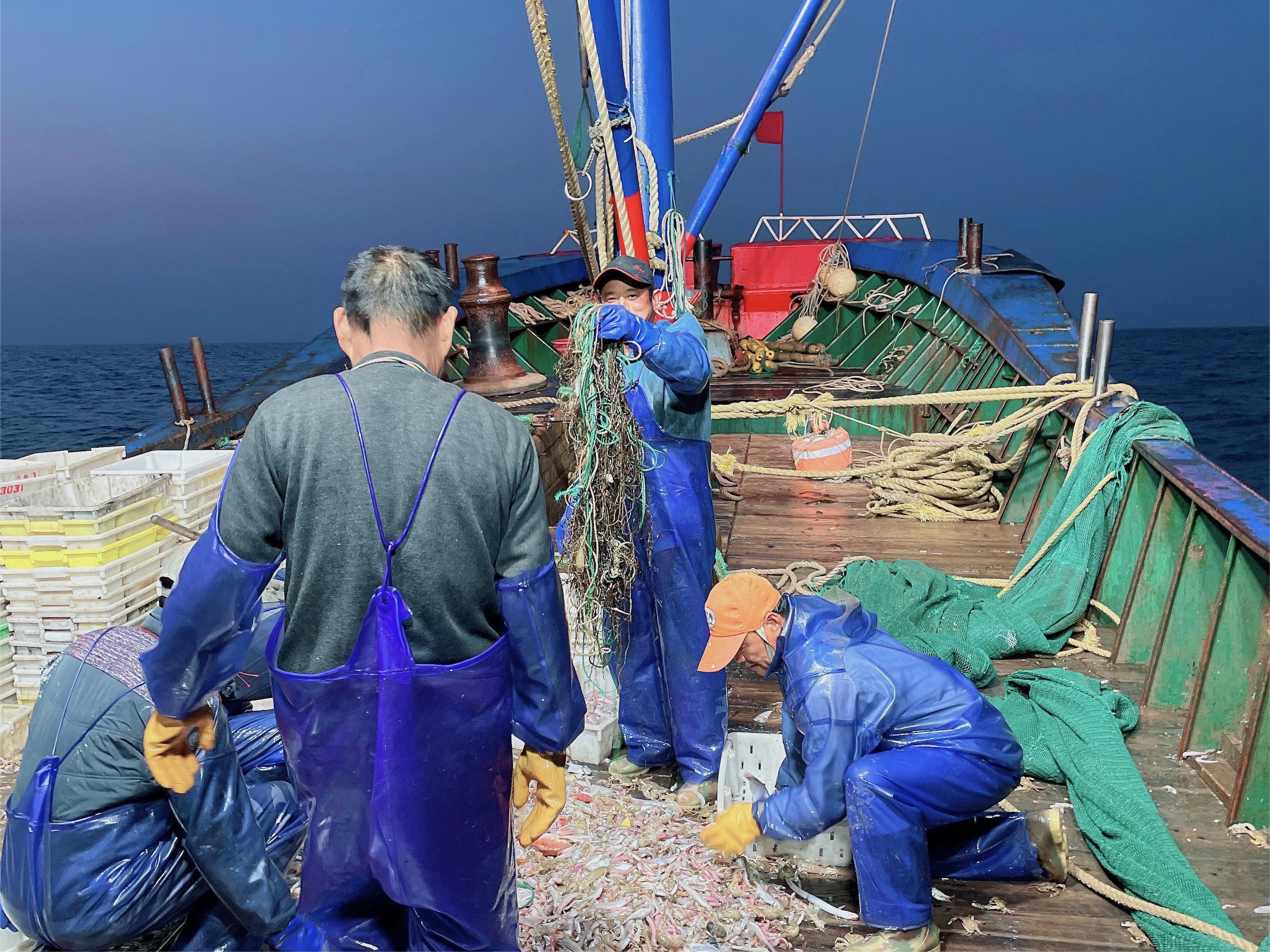Swimming crabs, also known as portunid crabs, are the star attraction in the waters off Zhoushan, Zhejiang province.
They have long lured droves of fishing vessels to this, China’s largest fishing ground. Fishers commonly use cheap, single-use, plastic gillnets to capture these highly sought-after crabs.
A vertical wall of netting kept upright by floats and weights. The mesh size of gillnets are chosen depending on the target species, though bycatch is a recurrent problem. Gillnets are used all over the world in both small- and large-scale fisheries.
While waiting to haul in a catch, fishers usually have something else to worry about. If the floats attached to the net are not moving, the net is usually caught on something – a shipwreck, a rocky reef, an abandoned shipping container, or a heap of discarded fishing gear.
Fishers have encountered this gear, also known as “ghost gear”, and other debris more frequently in the last two decades, as the number of fishing vessels has grown.
Yu Shanhai first went to sea as crew when he was 16, so his affinity with the Zhoushan fishing ground goes back more than four decades. “There’s a lot of stuff down there now that didn’t used to be there at all,” he told Dialogue Earth.
Yu says that while fishers cannot see conditions under the surface, they know from experience to avoid anchoring and lowering their nets in places with a lot of debris.
Even so, fishing nets frequently snag underwater. The fishers have a saying that “Seven nets out of ten get snagged”. If they are lightly damaged, they can be re-lowered somewhere else, but badly damaged ones are cut loose before they caught a thing.
These damages not only cost fishers but also exacerbate the ghost gear problem.
The durability of plastic nets means they continue doing their job long after being discarded, ensnaring marine animals, which may be injured or killed.
Experts tell Dialogue Earth that China has very few policies to address ghost gear. Legal provisions could help, they suggest, as well as financial incentives for recovering gear and management measures.
How serious is the ghost gear problem?
“If not for this job, I would never have believed how serious the ghost gear problem was,” Wang Yixin told Dialogue Earth. Wang was the co-founder of Zhoushan City Green Marine Ecology Promotion Center (Zhoushan GMC).
The organisation he led undertook a survey of discarded fishing gear in the Zhoushan fishing ground in 2021. The findings showed that most of the ghost gear in the area was made up of single-use gillnets used for catching crab.
Wang says that the portunid crab fishing grounds are always packed during the autumn season. At peak times, up to 2,200 vessels operate in the 35,000 sq km zone.
The gillnets used to catch them are made up of individual net panels seamed together, and can be a few nautical miles wide. A single fishing vessel gets through 50,000 to 80,000 net panels per year, with a discard rate of about 4-6% at sea, the others being taken ashore. By a rough estimate, at least 18,600 tonnes of disposable gillnets for crab were added to the fishing ground in 2021.
The problem of ghost gear is not confined to Zhoushan, but from interviews undertaken for this article, Dialogue Earth is not aware of any survey carried out at a national level.
Globally, a 2020 report by WWF shows that around 500,000 to a million tonnes of fishing gear are abandoned in the global ocean every year, threatening biodiversity.
As countries are negotiating a UN treaty to end plastics pollution, environmental campaigners are pushing for a provision on ghost gear to be included.
Fishers need incentives
Fishers are both polluter and victim when it comes to ghost gear, but they could also be a solution. Yu Shanhai says they increasingly recognise the seriousness of the issue.
“Whatever debris we encounter, we would pretty much bring it all back. Otherwise, you run into it again the next time.”
Yu Shanhai, now a captain himself, leads a vessel with more than a dozen crew. He says he has the crew clean up any snagged gear that can be hauled up. It’s later taken ashore for disposal. However, crews are not always cooperative about the additional work.
“Fishers’ work is exhausting,” says Jiang Xian’an, head of integrated management at Zhoushan GMC. They basically work flat out for two months non-stop when they are at sea, he explains. The lowering of nets at 4am is followed by a nap, hauling in the catch, sorting, freezing, and then after a brief rest another round of lowering the nets.
Dealing with retrieved ghost gear is a nuisance for crews. Jiang explains that the items hauled aboard tend to be mixed with trash fish and covered in silt and seaweed, which reeks and needs hosing off. Then there is the tricky matter of making space for it in the tight confines of the boat. Storage next to the catch would be unhygienic, and anywhere else intrudes on the limited living space.
Yu says that for now they rely on regular supply ships to take the waste back to land.
“What helps with fishers is money,” Jiang says bluntly. “Without compensation, it’s hard to get them to feel committed.” At present, there are no specific subsidies encouraging fishers to recycle waste fishing gear, the price for which is “very cheap”.
No closed incentive loop as yet
Wang Yixin says fishers are likely to dump nets overboard because extreme weather makes retrieving them difficult or otherwise they form a safety hazard, cramp the boat, and recycling companies will not pay much for them.
Fully recovering ghost gear involves collection at sea, transport to port, then by vehicle to a recycling site, and detoxification. Fishers’ willingness to take part is key to initiating that process.
“Awareness alone will not be enough if we are to encourage fishers to bring scrapped gear back with them. They must feel valued. Capitalising on the sorted gear enables fishers to reap the financial benefit through a reward system.”
Wang’s organisation is looking at promoting a market-based recycling model that involves fishing communities. For instance, they are exploring schemes that turn marine plastic waste into high-value stationery and household products for export, which label the origin of their recycled materials. Several other groups in Zhoushan and other coastal areas are promoting similar, public-interest schemes.
An FAO report shows that recycling plastic products has its limitations. Mechanical recycling, which involves washing, crushing and processing plastics, is energy intensive and creates air pollution. While chemical recycling, to transform waste plastic into usable elements, can cause heavy-metal pollution. Recycling fishing gear is therefore only a temporary, transitional measure.
Changing fishing methods is the fundamental solution. According to Wang: “Line fishing instead of catching with nets is the most realistic option at present. The number of live fish caught this way is small. But the price is multiple times that of regular fish and profit is decent for the fishers. In this way, the quality improves for consumers while the environmental burden comes down.”
As for crab fisheries, Wang says deploying single-use gillnets is the most economical and efficient method. Regulating the volume of fishing net deployment and limiting the number of fishing licenses in the area can bring the situation under control, he says.
Drawing on folk culture could perhaps help raise awareness, too. Han Han, president of ChinaBlue Sustainability Institute in Hainan, says that recourse to the Chinese sea goddess of Mazu and other customary culture could cultivate fishers’ reverence for the sea, helping curb the practice of dumping.
No specific legal basis yet
Ma Yong, deputy secretary-general of the China Biodiversity Conservation and Green Development Foundation, told Dialogue Earth: “The question of discarded fishing gear only came to the forefront in recent years. So there are relatively few legal regulations.”
China has no laws that directly address ghost gear, he adds. A few provisions concerning prevention and control of plastics touch on the issue, “but they are very limited”. Therefore, legal proceedings or penalties resulting from discarding gear are rare.
“It’s pointless to talk of managing this legally without having the necessary regulations,” Ma says.
If ghost gear were to be brought under the legal system, there would be a designated authority responsible for managing the issue and a legal basis for regulation and enforcement, he explains.
Reducing the problem at source
“The way to tackle the discarding issue is to introduce an end-to-end process for managing fishing gear,” according to Zhang Yanxuedan, associate professor at Shanghai Ocean University and a consultant to the FAO.
The nation’s current system for prohibited fishing gear makes standardised management difficult. A list of proscribed gear, in effect since 2015, bans the manufacture, sale and use of 13 types of net. Anything not on the list is theoretically permitted, explains Zhang. As a result, an enormous range of gear can be used, including slightly modified versions of the banned items.
Establishing a directory of permitted gear would be a good start, Zhang adds. Net designs incorporating poor-quality materials or inappropriate mesh size would be excluded, to reduce harm to marine wildlife.
The directory should also set out the models and specifications of gear that can be used, to facilitate subsequent management. Systems such as this are used extensively in the US, EU and elsewhere.
The directory, suggests Zhang, could work hand in hand with the entry-and-exit reporting system which has recently come into force. This system will require vessels entering and leaving fishing ports to declare the types and quantities of gear they carry, as well as the status of their logbook, crew, and catches.
As for retrieving ghost gear, Zhang says fisheries authorities can be encouraged to do so in areas where the safety of shipping navigation is at stake. However, implementing large clean-up operations would be very costly and difficult.
